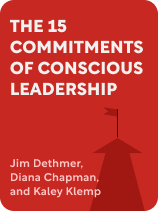

This article is an excerpt from the Shortform book guide to "The 15 Commitments of Conscious Leadership" by Jim Dethmer, Diana Chapman, and Kaley Klemp. Shortform has the world's best summaries and analyses of books you should be reading.
Like this article? Sign up for a free trial here.
Why should you make your happiness a priority? Why are leaders better when they’re happier on and off the job?
The 15 Commitments of Conscious Leadership says that the best leaders are ones that prioritize happiness and positivity. Doing so will help you avoid stress, increase your energy, and maximize your effectiveness.
Here are a few methods for prioritizing happiness and positivity.
Method #1: Find Contentment Within Yourself
The authors explain that many leaders struggle to feel happy in life because, like many humans, they believe they lack three things: safety, acceptance, and power. They, therefore, seek these three things externally—for instance, they try to gain safety by acquiring financial power over others, or they prioritize getting rich so they can feel accepted by their community.
However, believing you lack these factors and chasing them externally doesn’t help you make your happiness a priority. Instead, it causes dissatisfaction, stress, and suffering. This is because true contentment comes from recognizing you already have these things within you—you don’t “lack” anything at all.
Finding contentment within is the only way to achieve authentic, long-lasting happiness. To do so, acknowledge the external factors you seek (such as power over others or wealth), and then simply release these wants—try to exist in the moment as a person with no wants. Once you reach this state, acknowledge that you and your life are enough: It was only your wants that caused dissatisfaction. Once you release wants, you can feel content just with yourself.
| Achieve Fulfillment by Becoming One with Your Inner Self In A New Earth, Eckhart Tolle agrees that humans struggle to find happiness because they try to mitigate feelings of lack by seeking external factors like wealth and power. He elaborates that these feelings of lack stem from our ego, which has an underlying fear of never being enough—safe enough, accepted enough, powerful enough, and so on. Tolle explains we seek to fulfill these needs externally because our ego mitigates feelings of lack by inflating our self-image and gaining superiority over others. For example, the fancier your house is, or the more powerful position you have at work, the more “full” you’ll feel. However, like the authors of 15 Commitments, Tolle argues that searching for fulfillment externally (living in a state of what he calls “object consciousness”) only causes you more suffering because no matter how much you inflate your image, there will always be someone who’s better than you. This leads to what Tolle calls an “endless cycle of wanting,” in which you’ll never reach happiness because there’s always something “more” you’ll need to gain to achieve it. Similarly to the authors of 15 Commitments, Tolle argues that the only way to find contentment is to break free from your feelings of wanting—a process that he calls becoming one with your inner self, or your “pure consciousness.” We achieve this state by reaching a state of being or presence. Tolle says being has three components: 1) Nonattachment: When we no longer form attachments to things, we’ll no longer generate greed, consumerism, and pollution caused by the endless cycle of wanting. 2) Nonjudgement: When we no longer judge things as “right and wrong” or “good and bad,” we’ll no longer have unrealistic expectations that cause disappointment, anger, resentment, and other forms of suffering (for instance, if we judge something as “good” and it turns out to be “bad”). 3) Nonresistance: Consequently, we’ll cease resisting what simply is and can’t be changed. The authors of 15 Commitments recommend adopting nonattachment in this section (releasing wants), and nonresistance in the next section (going with the flow). They also recommend a process similar to nonjudgement when discussing how to take accountability—viewing any situation as neither good nor bad, right nor wrong, but just as something that is. |
Method #2: Have Fun and Go With the Flow
The authors explain that having fun and going with the flow also helps you feel more happy and more content in life. Having fun (what the authors call “play”) involves making time to do seemingly meaningless activities for the sake of enjoyment. Going with the flow means accepting rather than resisting uncontrollable circumstances in your life—acknowledging that they happen, and deciding how to move forward with creativity and flexibility to joyfully build upon what life gave you.
(Shortform note: When defining play and discussing its benefits, the authors cite the research of Stuart Brown, a psychiatrist and play researcher who founded the National Institute for Play. According to Brown’s research, play not only improves people’s physical and emotional well-being but is also fundamental to healthy human development. His research shows a link between a lack of childhood play (or play deprivation) and a future propensity to violence and other antisocial behaviors. Brown argues that healthy play is a means of developing important social-emotional skills and preventing potentially violent antisocial behavior.)
Method #3: Actively Change Things You Dislike
The authors explain that taking action to change things that you find unsatisfactory is key to developing a positive mindset. Many people see flaws in the world around them—whether in their relationships, their work, or society at large—and complain rather than taking action to improve things. This encourages the negative belief that things are imperfect and always will be. Instead, view imperfections as things you can change and opportunities to make the world a better place.
| Achieve Lasting Positivity by Addressing the Underlying Issue: The Negativity Instinct The authors’ recommendation to view flaws in the world as opportunities for change may encourage a more positive outlook temporarily. However, it might not be enough to instill lasting positivity due to a phenomenon called the negativity instinct. As Hans Rosling explains in Factfulness, this instinct convinces us that the world is fundamentally bad and getting worse. Because of the negativity instinct, even if you successfully manage to instill positive change in one aspect of the world around you, you’ll likely keep seeing more and more apparent flaws in need of change. In turn, this may trigger a more pessimistic outlook—you’ll see problems everywhere, and you’ll know that nobody could possibly solve them all. You may feel that trying to improve the world around you is a lost cause. To overcome the negativity instinct and adopt a more permanent positive outlook, Rosling recommends focusing on ways in which the world has improved, seeking out positive news, and not romanticizing the past (which we often view as a “better time” due to rose-tinted nostalgia). |

———End of Preview———
Like what you just read? Read the rest of the world's best book summary and analysis of Jim Dethmer, Diana Chapman, and Kaley Klemp's "The 15 Commitments of Conscious Leadership" at Shortform.
Here's what you'll find in our full The 15 Commitments of Conscious Leadership summary:
- Why many leadership models are unsustainable in the long term
- Why leaders must learn to understand and manage their emotions
- The 15 commitments that leaders must uphold to run an effective organization






